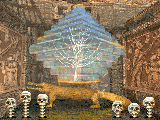Timelapse is an older game, reminiscent of the original "Myst." It was
published in 1996, back in a golden era when gaming companies thought they
could make a profit by giving the gamer dozens of hours of gameplay. The
game is huge, with knock-your-socks-off graphics and lots of attention to
detail. There are more puzzles in it than in "Myst," but in general I
would not consider it to be a harder game, probably about equal in
difficulty. Timelapse has stood the test of time, and (except for its now
trite back-story and lack of a 360-degree panning feature) feels quite
up-to-date.
You receive a phone message as the game opens. Your anti-establishment
(crazy) archaeologist buddy begs you to come to Easter Island. He has
found a "missing link" between ancient civilizations. In the long,
unbroken tradition of mad adventure game scientists, he plans to step
through a time portal (investigate a hitherto unknown world, etc.) and
wants you to be his back-up in case something goes wrong. Of course, your
buddy disappears and you have to try to rescue him.
There are a variety of puzzles in Timelapse, but the most intriguing tend
be the puzzles that deal with glyphs. You find various mysterious symbols
and then figure out how to organize and plug them into some other part of
the game. There is one extraordinarily difficult sliding tile puzzle,
which can become a real show-stopper. There is also a puzzle where you
shoot an arrow over a canyon (it can take an embarrassing amount of effort
to do this correctly). Add to the mix a couple of sound puzzles and some
reasonably easy mechanical puzzles. There is also one place where you have
to reassemble a skeleton – a challenge that sometimes gives gamers
trouble. (Hmm...Maybe this game IS harder than Myst.) There are no
traditional mazes although it is possible to get lost at first in these
large environments
In addition to its wealth of puzzles, Timelapse is distinguished by its
fascinating historical worlds -- Mayan, Anasazi, Egyptian -- each caught
in a moment out of time. Everything in these worlds has a new, pristine
quality about it. The Egyptian temple paintings, for instance, look as
fresh as if they'd been painted yesterday. All the interiors are perfect
-- not a faded pigment, chipped gold leaf, mark, worn spot or smudge
anywhere.
Although each time period is gorgeous, the most fantastic, IMHO, is the
Mayan world. Here you puzzle your way from white, sandy beaches -- through
temples full of multi-hued artifacts -- to the stepped pyramids half
hidden by lush rain forest. This game also has the most beautiful,
exotically colorful and detailed caverns and underground spaces of any
game I've played.
Such picture-perfect worlds are not without dangers. There is a dark
aspect lurking beneath the game's pretty exterior. For example, in one
location a mummy case contains an extremely nasty (ratty) surprise. And
you are occasionally harassed by a strange, shadowy humanoid that spits
angry threats (you meet him for real in the end game).
The crazy archaeologist buddy has kept a journal that contains clues and
descriptions of what he encounters in the various worlds. If you like to
read journals in games, you will enjoy this one very much.
There are also voices that echo through your travels. They give hints
while breaking your concentration and immersion. (The voice acting in this
game is NOT its strong point.) If you favor the spooky/mystical school of
acting, then you will be impressed. The music is eerie and fits the mood
of the game very well.
The game can be played entirely with the mouse. However, I found the
keyboard easier to use because a directional icon appears when you use the
keyboard, indicating at all times what directions you can take. The game
was quite stable.
If you make it through the sliding tile puzzle (and the rest of the
historical worlds), you get to go to Atlantis. Timelapse’s version of
Atlantis is quite unlike any other portrayal of the mythic city. There is
intricate etched glass everywhere. Shiny, reflective, patterned floors add
an ethereal quality (it would take magic or an advanced alien technology
just to keep the floors unscuffed). There are Art Nouveau glass sculptures
and wall paintings, plus historical motifs from Egypt, etc. Everything is
enclosed by a huge glass dome, with broken-down columns and other
structures on the sea floor outside. Crystalline New Age music plays in
the background. The whole thing is incredibly effective.
Sometimes (like when I'm trying to draw up my top fifteen list), I think
about gameworlds, and whether any of these worlds are large, elaborate,
complex and beautiful enough to tempt me to take up permanent residence.
Timelapse makes the very short list of gameworlds that I think I could
actually live in, though I would probably scuff the floors and mark up the
walls a bit to make it seem more homelike.
Final Grade: 4 BAAGS out of 5
copyright © 2003
GameBoomers
